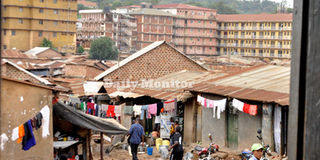Katanga: Where you can enjoy a meal at less than a dollar

While you can get a plot at Shs5m in Katanga, this will not be permarnent because Kampala Capital City Authority (KCCA) has lined up for development. Photo by Edgar R Batte.
What you need to know:
There are a number of slums around Kampala and Katanga is one of the popular ones though it is up for development.
When Hassan Wasswa first visited Katanga in 1987, it was full of temporary shelters made from papyrus, poles and mud wattle. He needed a house to rent and was referred to Keffa Matovu, who became his first landlord. He paid Shs4, 000 for the monthly rent for the house.
It was held together by poles, raw bricks and papyrus reeds like all the other houses in the area. His home was located in Kimwanyi, one of three zones that make up Katanga. Busia and Soweto are the other two zones. At the time, Wasswa was a small scale trader, dealing in matooke bunches and fingers that he could sell to residents who lived in the slum located between Mulago and Makerere.
Changing face
Wasswa, a Local Council (LC) one chairman of Kimwanyi, explains.
“Much of the land was given to Muganzi Awongelerwa by Kabaka Mutesa the first for successfully executing a role,” Wasswa adds.
Over the years, Wasswa says Katanga has changed face and lifestyle.
At the time he settled in the slum, there were no toilets and residents would defecate in the open.
With the kind of lifestyle, locals suffered from diarrhoea and dysentery and some children lost their lives. For Wasswa, this was a lesson learnt.
“It was no longer about zone. We needed to step up efforts to build a better Katanga for all of us. We called out to the Church of Uganda (CoU) and concerned Ugandans who built for us toilet facilities. Locals had to pay Shs50 to use the facilities which helped us acquire toilet paper and water,” the local
Recent developments
The idea of temporary houses was out of vogue for a place located two kilometres from the Central Business District (CBD).
“If someone needed to put up a house, he needed to first prove to me that they had iron sheets. I could not allow people to put up houses roofed with papyrus or covered with polyphone bags,” Wasswa recollects.
Francis Tumusiime, secretary production and environment, Katanga explains that people are not willing to relocate from the slum because rent is cheap and they do not have to incur transport costs since it is within walking distance from the city centre.
“Many of the locals that stay in Katanga are boda boda riders, taxi drivers, women who serve food around town, mechanics in garages, and more so renting a house for as low as Shs50, 000,” Tumusiime explains.
For a house of that amount, Wasswa says one gets a single room without a ceiling, dusty or muddy floor. For slightly more money or double, you can get a house with a ceiling, cemented floor and a window. However, if you will peep, you will realise that those renting the Shs50, 000 have devised ways of improving their houses.
They buy remains of tiles from construction sites of hostels within the same neighbourhood so they can improve their floors so floors will have multi-coloured tiles.
Wasswa adds that you can get a plot of land in Katanga at Shs5m. However, Katanga has been a target for developers, the latest being Kampala Capital City Authority (KCCA).
Shs 50,000
Amount in shillings you need to rent a single-roomed house in katanga
History
Matovu says Katanga, from what he gathered, got its name from refugees it hosted from Zaire, a country that has since been renamed Democratic Republic of Congo. “The refugees who had left Zaire settled here and because most of them had come from Katanga in Zaire, the place took on the name,”




